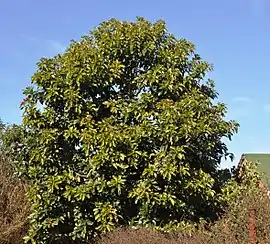mũkũyũ
Kikuyu

mũkũyũ (Ficus sycomorus)

mũkũyũ (Ficus sur)
Pronunciation
- IPA(key): /mòkòjóꜜ/
- As for Tonal Class, Benson (1964) classifies this term into Class 3 with a disyllabic stem, together with kĩhaato, mbembe, kiugo, and so on.
- (Kiambu)
- (Limuru) As for Tonal Class, Yukawa (1981) classifies this term into a group including bũrũri (pl. mabũrũri), ikara, ikinya, itimũ, kanitha (pl. makanitha), kiugo, kĩhaato, maguta, mũgeka, mũkonyo, mũrata, mwana, mbembe, mbũri, nyaga, riitho, riũa, rũrĩmĩ (pl. nĩmĩ), ũhoro (pl. mohoro), and so on.[1]
Noun
mũkũyũ class 3 (plural mĩkũyũ)
Related terms
(Nouns)
- ngũyũ class 9/10
See also
- mũgumo, mũũmbũ
References
- Yukawa, Yasutoshi (1981). "A Tentative Tonal Analysis of Kikuyu Nouns: A Study of Limuru Dialect." In Journal of Asian and African Studies, No. 22, 75–123.
- “mũkũyũ” in Benson, T.G. (1964). Kikuyu-English dictionary, p. 249. Oxford: Clarendon Press.
- Dharani, Najma (2002). Field Guide to Common Trees & Shrubs of East Africa, p. 112. Cape Town: Struik Publishers. Rep. 2005. →ISBN
- Dharani, op. cit., p. 111.
This article is issued from Wiktionary. The text is licensed under Creative Commons - Attribution - Sharealike. Additional terms may apply for the media files.